 Welcome to the age of buyer empowerment. In embracing the aim of enabling B2B buyers, we naturally position the customer’s journey as a pivot point for our business plans and decisions. The Knowledge@Wharton network features a Dell-sponsored article with a revealing title: “Customer Journey Mapping Is at the Heart of Digital Transformation.” A recent McKinsey blog emphasizes the need to put customers’ “end-to-end journeys” at the center of our commercial decision-making. Understanding customer journeys is rapidly becoming an organizing framework, not just for product managers and marketers, but also for customer success, support, and services professionals.
Welcome to the age of buyer empowerment. In embracing the aim of enabling B2B buyers, we naturally position the customer’s journey as a pivot point for our business plans and decisions. The Knowledge@Wharton network features a Dell-sponsored article with a revealing title: “Customer Journey Mapping Is at the Heart of Digital Transformation.” A recent McKinsey blog emphasizes the need to put customers’ “end-to-end journeys” at the center of our commercial decision-making. Understanding customer journeys is rapidly becoming an organizing framework, not just for product managers and marketers, but also for customer success, support, and services professionals.
The McKinsey team, however, takes an additional step, recommending that we jettison our assumptions, using zero-based design to map business processes against customer journeys. Eliminating bias is commendable, but following the McKinsey recommendation to its extreme, where we strip away all assumptions, makes the process very abstract. Identifying a clear beginning and a clear end of the journey sounds good in theory, but becomes difficult in practice without a modicum of structure. The possibilities are endless, leaving us to make sense of many customer circumstances, multiple journey pathways, and a wide array of potential endpoints.
Customer Value: A Simple Destination for B2B Customer Journeys. Business customers, embarking on a buyer’s journey, have a simple destination: the endpoint of their customer journey is value. After all, their performance is measured by their profitability. Customer value realized is the rising tide that lifts all boats, cutting through politics, overcoming personal insecurities, and clarifying decisions by committee. The value outcome of a customer journey is ultimately one-dimensional and can be measured in dollars (or euros) and cents. To simplify B2B buyer journeys, we should work backwards from realized customer value.
 Customer Value Management focuses commercial teams on customer outcomes that result from the decision to buy our offering. Asking value questions drives us towards an objective way to measure those outcomes. By translating our product features into customer-centric benefits, measured by bottom-line results, value simplifies customer discussions, managing expectations, and identifying the deliverables that matter.
Customer Value Management focuses commercial teams on customer outcomes that result from the decision to buy our offering. Asking value questions drives us towards an objective way to measure those outcomes. By translating our product features into customer-centric benefits, measured by bottom-line results, value simplifies customer discussions, managing expectations, and identifying the deliverables that matter.
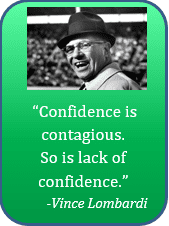 The business benefits of value modeling, value pricing, and value selling are clear enough. The evidence shows that implementing a value based-pricing strategy improves EBITDA by an average of 8%[1] and that the ROI of investing in value based strategies ranges from 130% to 900%.[2] Product teams who incorporate value into their internal deliberations say that it helps them understand their positioning better and that it makes their decision-making customer-centric. CRM data from B2B organizations adopting value selling show that opportunities where a Value Proposition is used have 5-15% higher win rates and 5-25% higher price outcomes. At a psychological level, this is no surprise. By understanding the value of our differentiation, we build conviction in our competitive advantage. Confidence in our differentiation provides a foundation for sales confidence. Sales confidence delivers results, moving a buyer beyond “no decision,” deflecting cheap competitors, and realizing higher prices.
The business benefits of value modeling, value pricing, and value selling are clear enough. The evidence shows that implementing a value based-pricing strategy improves EBITDA by an average of 8%[1] and that the ROI of investing in value based strategies ranges from 130% to 900%.[2] Product teams who incorporate value into their internal deliberations say that it helps them understand their positioning better and that it makes their decision-making customer-centric. CRM data from B2B organizations adopting value selling show that opportunities where a Value Proposition is used have 5-15% higher win rates and 5-25% higher price outcomes. At a psychological level, this is no surprise. By understanding the value of our differentiation, we build conviction in our competitive advantage. Confidence in our differentiation provides a foundation for sales confidence. Sales confidence delivers results, moving a buyer beyond “no decision,” deflecting cheap competitors, and realizing higher prices.
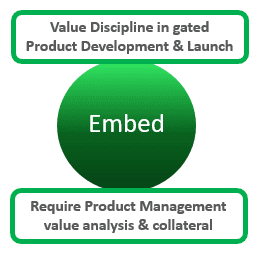 Programs to Support Value Management Disciplines. In previous blogs, we have highlighted disciplined approaches that the best B2B enterprises use to embed customer value in gated product development and launch processes and in existing product management processes.
Programs to Support Value Management Disciplines. In previous blogs, we have highlighted disciplined approaches that the best B2B enterprises use to embed customer value in gated product development and launch processes and in existing product management processes.
All good military, sports and business disciplines come from the top, resulting from some combination of marching orders and leadership by example.
But implementation of effective Value Management, like any other change initiative, requires more than a CEO decree, a memo from the head of R & D, or a new section of the employee handbook. Adopting Value Management requires education, practice, and ongoing programs that support the execution of value strategies. In any organization, some individual or group of individuals must be responsible for, and empowered to drive, an effective Value Management process.
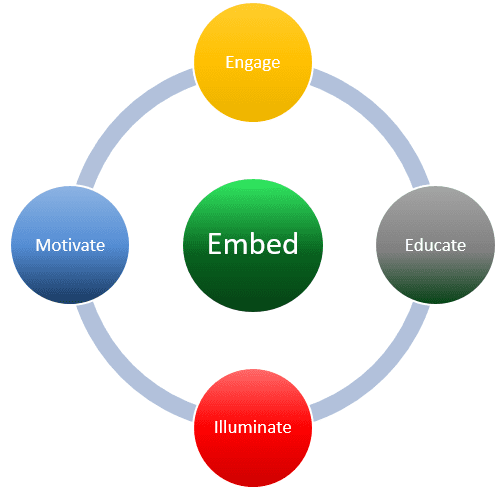 Sometimes leadership for Value Management is prominently vested in a Chief Value Officer. Some organizations set up a core team as a full-time Value Office, with responsibility to serve as a resource as they drive best practices in Value Management and Value Selling. In many other organizations, members of the C-suite, value champions, and value coaches are designated as a value task force with part-time roles. Their role is to act as evangelists and drivers of best practices in Value Management and/or Value Selling.
Sometimes leadership for Value Management is prominently vested in a Chief Value Officer. Some organizations set up a core team as a full-time Value Office, with responsibility to serve as a resource as they drive best practices in Value Management and Value Selling. In many other organizations, members of the C-suite, value champions, and value coaches are designated as a value task force with part-time roles. Their role is to act as evangelists and drivers of best practices in Value Management and/or Value Selling.
Regardless of the approach to leadership, it is essential that a core team be focused on the following four objectives when it comes to customer Value Management:
- Engage
- Educate
- Illuminate
- Motivate
Let’s look at practical approaches to each of these objectives in turn that have been proven to be effective.
 Engage. In some organizations, making the transition from a product focus to a customer focus is a huge challenge. Product managers, R & D personnel, and other experts are so used to solving technical and operating problems that they find it difficult to shift their focus to the customer, understand the benefits that their product delivers, and capitalize on the customer value that results.
Engage. In some organizations, making the transition from a product focus to a customer focus is a huge challenge. Product managers, R & D personnel, and other experts are so used to solving technical and operating problems that they find it difficult to shift their focus to the customer, understand the benefits that their product delivers, and capitalize on the customer value that results.- Value champions should present developed Value Propositions regularly to internal best practice groups, including commercial excellence forums, development committees, marketing roundtables, and pricing councils, providing substantive examples of good content along with narratives as to how that content was used to make decisions. These presentations heighten middle management awareness, challenging participants previously unengaged in customer value, to up their game.
- Value champions should present Value Propositions at trade shows, thought leader meetings, and customer meetings, putting customer outcomes at the center of external conversations, demonstrating that customers want to talk about measurable results, and addressing sales reluctance to convey financial value to their accounts.
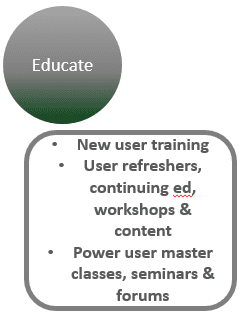 Educate. Conveying the idea that we are in business to create value for our customers, is a good start in shifting attitudes toward customer outcomes, but it is not sufficient to develop good Value Management skills among a broad user group. As with any skill set, training needs to be part of the program, not just at implementation, but on a regular basis, re-enforcing previous learnings, answering objections, helping users solve problems, and developing ever-improving capabilities.
Educate. Conveying the idea that we are in business to create value for our customers, is a good start in shifting attitudes toward customer outcomes, but it is not sufficient to develop good Value Management skills among a broad user group. As with any skill set, training needs to be part of the program, not just at implementation, but on a regular basis, re-enforcing previous learnings, answering objections, helping users solve problems, and developing ever-improving capabilities.
Training content should not be one-size-fits-all, but should be based on roles, both to maximize engagement and to be efficient with users’ time. Those involved in quantifying value (e.g. product managers, marketing and pricing professionals) need to develop skills that enable them to: (i) ask the right questions, (ii) figure out where to obtain useful information, and (iii) get the math right. Those involved in setting value based prices need to supplement their value quantification skills with a good understanding of pricing strategy. Those generating content to communicate value (usually overlapping with groups who quantify value) need to shift their thinking away from the analytics and the math and towards how their sales colleagues, with less product-specific expertise, will be empowered to tell a meaningful value story and engage in customer conversation.
By contrast, basic training for those selling value rarely requires developing value quantification skills. Overtraining sales users on technical or analytical detail is high risk, even as improving their confidence in asking good questions and introducing value early through case study conversations has a significant payoff. Presales users, including solution consultants and customer-facing subject matter experts, may need deeper content training, given their specialized role to demonstrate value, customize solutions, and adapt a business case to buy for customer stakeholders, but value quantification skills for these users is usually unnecessary. For customer success and service team members, it is important to deploy skills and use tools that help track goals, manage their attainment, and realize the resulting value, but value quantification skills again may not be a priority.
For content creators engaged in Value Management and decision-making, value champions should consider ongoing education programs from the standpoint of at least three types of users.
- New users, including new members of the team and members of the team with new roles, need to understand their objectives, the importance of value, and how to get underway with a value tool-kit. Most commercial teams are in continuing flux, with changes in responsibilities and personnel turnover. Regular new user training not only addresses inexperienced members of the team, but also enhances the capabilities of those who need to solidify basic skills.
- Broader groups of ongoing users need refreshers and continuing education, invariably mixed with motivation, that re-enforces their basic training and stimulates them to develop deeper value understanding. Practical, skill-targeted workshops that help commercial teams make progress toward their deliverables are a means to take skills and content to the next level. For product managers, marketing, and pricing professionals, programs can focus on specific topics: pricing strategy, designing good Value Propositions, how to have customer value conversations, value based segmentation, value chains, offering design and packaged solutions. In addition, providing regular, relevant content to this broad user group with newsletters, webinars, and videos helps to motivate as it deepens their skill sets.
- For members of the Value Office, power users and champions in any value task force, the objectives are different. It is critical to enhance skills and best practices among this group as well – their participation and leadership in broader group sessions is essential. But the objective with these evangelists is to help and challenge them to improve how they drive best practices with other team members based on what is working and what is not. To this end, power user programs should include forums, master classes, and seminars, that enable them to learn from each other about how to address coaching challenges and how to drive high quality adoption.
This blog is focused on content creators and Value Management, but for sales, presales, and customer success users, ongoing value training programs should be distinct and should focus on recommended Value Proposition content and value selling skills, that include specific examples and practice of how to use value in customer conversations.
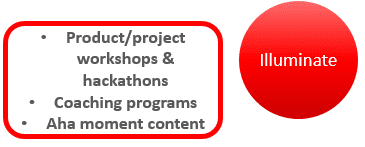 Illuminate. Formal training is great, but it needs to connect to practical, relevant applications. Value Management creates insights and there are systematic ways to improve and re-enforce the illumination it provides.
Illuminate. Formal training is great, but it needs to connect to practical, relevant applications. Value Management creates insights and there are systematic ways to improve and re-enforce the illumination it provides.
- Embed educational content (highlighted above) into working sessions with useful, defined deliverables. Workshops and hackathons can be designed to deliver any or all of the following: (i) a good value map of a market, (ii) a value model for a new or existing product, (iii) a set of offerings and a pricing structure for a new or important product, (iv) a Value Proposition for sales use. Getting all the way to these deliverables in a single session is usually challenging, but making substantive progress, with identified near-term follow-up, is an achievable aim. Group collaborations that result in collective commercial insights become a reason to repeat the exercise for the next project or product.
- Providing coaches for projects and products is a useful supplement to workshops to cross-pollinate knowledge and skills among the broader team. Coaches who pose good questions and who provide advice and experience can go far in improving the quality of value content and strategic decisions based on that content. Whenever the light bulb is switched on for a product manager with a positioning or pricing challenge, the usefulness of focusing on customer value is re-enforced. Good coaches provide perspective, helping to stimulate out-of-the-box thinking, new questions, and creative solutions
Value programs provide important insights into product positioning, pricing strategy, segmentation, and offer design. These insights improve decision-making, sometimes in ways where the quantified impact is imprecise, but where users recognize and appreciate significant benefits. Capturing the “aha moments” that result from these insights, along with how they change commercial decisions, provide success stories that highlight the benefits and usefulness of value modeling.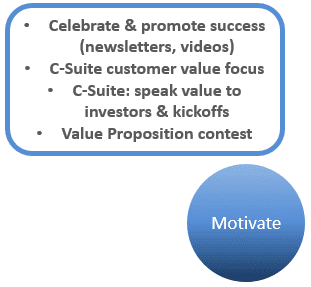 Motivate. All good programs motivate. Energy is required to implement and sustain best practices. Any energy generated dissipates when continuing motivation is absent. There are several widely-used approaches to motivate Value Managers in initial implementations and on an ongoing basis.
Motivate. All good programs motivate. Energy is required to implement and sustain best practices. Any energy generated dissipates when continuing motivation is absent. There are several widely-used approaches to motivate Value Managers in initial implementations and on an ongoing basis.
- Celebrate and promote success. As already highlighted, understanding value provides insights that change commercial decision-making in fundamental ways. The insights that come from specific applications of Value Management, together with their impact on segmentation, pricing, offer design, and execution, represent success stories. Preparing these success stories for internal forums, education sessions and workshops is essential to the success of these programs. Disseminating them regularly and broadly through newsletters or with short videos is a way to refresh and renew the motivation coming from programmatic events.
- Brief the C-suite routinely on the customer value of products and services, condensing value information to essentials. This can be driven by team members who have developed good value content, but it should also be driven by systematic, top-down questions and requests from the C-suite. “How does that product generate customer value?” “Do we have customer case studies on the economic benefit of our service?” “Tell me about our pricing structure and how we are capturing value.” “As preparation for this customer meeting, please come up with an overall estimate of how much money we made for them this year.”
- Tone comes from the top. The C-suite needs to speak value to investors, to the media, to the Board, and in kicking off internal meetings. This is only possible if value briefings are a routine part of C-suite preparation, but that value needs to be communicated directly by the C-suite. A video clip of the CEO highlighting the two or three quantified differentiators of a product about to launch in a 5 minute interview with a financial reporter should play repeatedly on internal channels. Value selling success stories told by the C-suite in sales kickoffs help to drive sales interest and engagement. A summarized value statement in C-suite-to-C-suite customer meetings redirects the tone of the meeting from an adversarial price discussion to a win-win discussion of how to create more value in collaborative partnership.
- Implement a Value Proposition contest. A friendly contest among product managers within or across divisions is a great way to elevate quality Value Propositions in an organization. It is also a way to get product managers to allocate time from their busy schedules to understand and effectively present customer value. Set up the contest with 3-5 competing teams. Provide the teams with marketing support and coaching. Early in the contest, set a date for sequential 20 minute (virtual) presentations by each team in front of a panel of judges and other contestants. Invite a member of the C-suite to be a judge. Encourage dry runs. Reward winners with public high-fives in internal newsletters, videos, and best practice forums. 2-3 months after the contest, ask each contestant how they have used the Value Proposition internally and with customers. Have they encouraged other members of the team to use it? Track outcomes of the Value Propositions internally. Publicize successful use of Value Propositions.
These approaches motivate as they highlight best practices. Motivation is an important part of sustaining and continually improving an ongoing Value Management program.
In other organizations, the terms “customer value” and “Value Proposition” are widely used but are empty words, lacking in substance and rigor in how they are used. Notions that value can be measured objectively, that quantified value can be used to make decisions, or that sales teams can have financial and numerical value conversations are often foreign to these organizations.
In either case, communicating Value Propositions broadly within and outside the company is a good start to driving change. By presenting a strong, specific Value Proposition for a product, a service, or a customer relationship, value champions engage a broader audience, providing good examples for others to copy. Concrete, well designed Value Propositions help to standardize language, driving a change in mindset and an increase in confidence.
In conjunction with good Value Management disciplines, several concrete steps support these objectives by engaging the broader team in good value conversations.
Internal presentations by product managers and subject matter experts should be made as if they being used in direct customer conversations. Value Propositions targeted toward a customer’s mindset should invite and empower the customer to realize and appreciate the value of buying through the course of their buyer’s journey.
The insights that good Value Management provides are a primary reason to adopt the discipline. Generating and emphasizing these insights, while bolstering and supplementing skills, should be a part of any good program.
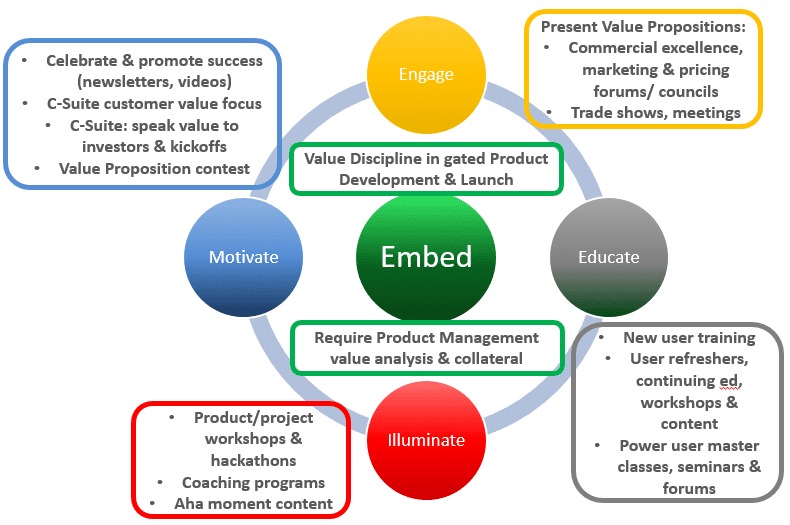
Adopting Value Management for Decision-Making. Great B2B organizations are customer-centric. As innovative businesses, they embed disciplines to make their product and pricing decisions based on customer value. They drive their product managers to understand and execute on value in their brand plans and in the way they support marketing and sales. The beneficial insights Value Management generates and the enhanced customer awareness Value Managers experience improve decisions. The programs it takes to embed high quality Value Management are not difficult to execute and don’t require a large expenditure. The ensuing quality of plans, decisions and execution deliver business results at a high multiple of the investment and effort required.
To learn more about how to quantify value see:
Can Your Sales Team Sell Your Solution’s Value?
To learn more about how sales teams use Value Propositions see:
Value Propositions for B2B Sales Effectiveness
[1] See John Hogan, “Building a World-Class Pricing Capability: Where Does Your Company Stack Up?” Monitor Group Perspectives, 2008.
[2] See Stephan Liozu and Andreas Hinterhuber, eds., The RoI of Pricing, Measuring the Impact and Making the Business Case (Routledge, 2014), especially the chapter by Stephan Liozu, “RoI and the impact of pricing: the state of the profession.”

